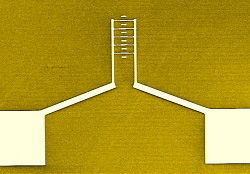Photons Crowd Each Other Out

Technologies of the future like quantum computers will need to manipulate single electrons, atoms, or photons. Researchers can already control single electrons, but photons are trickier, since they have no charge. In the 6 May print issue of PRL, a team shows a new way in which individual photons might be coaxed to stop and go, by using microscopic pinholes as temporary photon “holding pens.” The process is analogous to the jumping of single electrons onto tiny metallic islands called quantum dots. Although experts see some technical problems with the experiments–and the output is not yet at the level of single photons–they say the idea is good and should encourage more research.
Electrons can jump (tunnel) one at a time, from an electrode onto a quantum dot. Each additional electron on the dot increases the repulsion that future tunneling electrons experience, an effect called Coulomb blockade. According to theories for a “photon blockade”–where photons move singly across a gap–each transit must cause an intervening material to become temporarily opaque, to block the next photon. Although a few techniques exist for creating single photons, no one has put the photon blockade idea into practice until now.
Igor Smolyaninov of the University of Maryland and his colleagues predicted that the small cracks in a gold film painted onto a glass surface could regulate photons in the right way. Although the holes would be much smaller than the light’s wavelength–and therefore too small to allow ordinary transmission–they would be filled with an organic material that would help photons across. Visible light could scoot through these holes because photons would excite metal surface electrons (plasmons) that would carry the energy through the hole, re-emitting it as light on the far side. According to the theory, even a single photon’s worth of energy would temporarily alter the fields in a hole and block the next photon, but only if the polymer were present.
To try out their idea, the team deposited gold on a glass surface and then coated and filled the film’s gaps with the polymer. They shined laser light through the glass and collected the transmitted light by positioning a small optical fiber above individual holes. For some of the holes, as they increased the laser intensity–and therefore the number of photons–the transmission stopped increasing, as the holes appeared to “saturate.” At higher intensities, the transmission increased and saturated again, creating a “staircase” plot. The saturation suggests that, with further improvements, individual pinholes could regulate the passage of single photons.
“I think the idea of the paper is pretty neat,” says Cristiano Ciuti of the University of California at San Diego. But he says the experiments would have been more convincing if they included comparisons of different wavelengths of light, since the plasmon effect should be optimized in a certain wavelength range. “This paper will encourage new research in this very important field,” says Vladimar Shalaev of Purdue University. But he too felt that the experiments needed more sophistication. Smolyaninov responds that the team’s goal was simply to provide some evidence, for the first time, for a scheme that might allow single photon tunneling, and he agrees that much work needs to be done.
–Sarah Lesher
Sarah Lesher is a freelance writer in Silver Spring, MD


